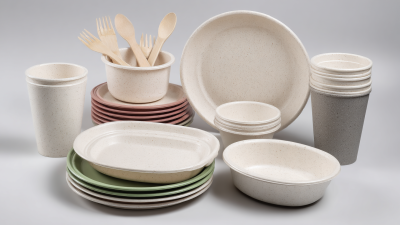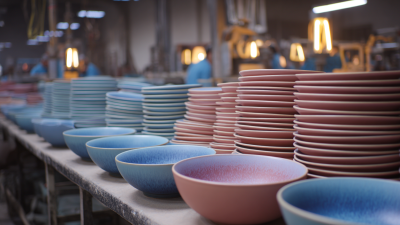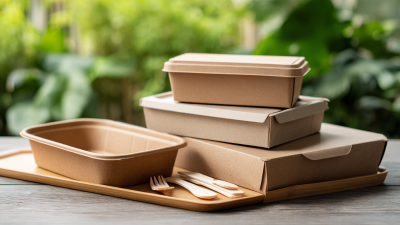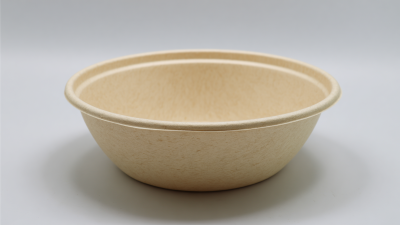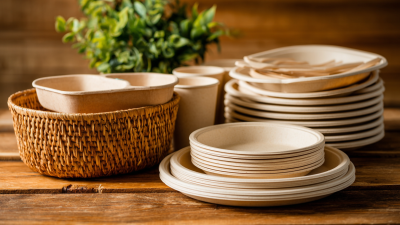As consumers increasingly gravitate towards sustainable dining practices, the demand for biodegradable crockery has surged. According to a report by Smithers Pira, the global biodegradable tableware market is expected to reach $9.6 billion by 2024, growing at a compound annual growth rate (CAGR) of 13.2%. This shift signifies a collective commitment to reducing plastic waste and enhancing eco-friendly dining experiences. Choosing the right biodegradable crockery not only reflects a brand's environmental responsibility but also ensures compliance with increasing regulatory standards around single-use plastics. From compostable plates made from renewable resources to stylish, functional designs, selecting the most suitable options can be overwhelming. This ultimate checklist serves as a guide to help consumers and businesses make informed decisions that align with their sustainable dining needs while fostering a greener planet.

When it comes to sustainable dining, choosing biodegradable crockery is an essential step towards reducing our ecological footprint. One of the key advantages of using biodegradable options is their ability to break down naturally over time, unlike traditional plastic which can linger in landfills for centuries. This rapid decomposition process not only minimizes waste but also contributes to soil health, making it a favorable choice for environmentally conscious consumers.
In addition to their environmental benefits, biodegradable crockery often enhances the dining experience. Many of these products are made from renewable materials like bamboo, palm leaves, or recycled paper, which not only provide a more rustic and appealing aesthetic but also foster a connection with nature. This can enrich the atmosphere of any dining occasion, from casual gatherings to formal events. Choosing biodegradable crockery not only reflects a commitment to sustainability but also elevates the experience for guests, making it a win-win scenario for both the planet and your dining experience.
When it comes to sustainable dining, choosing the right biodegradable crockery is crucial. There are several types of materials that can be used for eco-friendly tableware, each with unique properties. For instance, products made from bagasse, a byproduct of sugarcane processing, are not only biodegradable but also sturdy and heat-resistant. According to a study published by the Ellen MacArthur Foundation, switching to such materials can significantly reduce ecological footprints, with potential reductions in CO2 emissions by up to 70% compared to traditional plastics.
Another popular option is compostable PLA (Polylactic Acid) made from cornstarch. This material decomposes in industrial composting facilities within 90 days, making it a great choice for eco-conscious consumers. It is essential, however, to ensure that these products carry the proper certification, such as the BPI (Biodegradable Products Institute) mark, to confirm their compostability under specific conditions.
**Tips for selecting biodegradable crockery:** Always consider the purpose of your event; heavier-duty options like bagasse are suitable for hot foods, while PLA works well with cold items. Additionally, research the local composting facilities available in your area to ensure the best disposal method for your chosen items. By making informed choices, you can enjoy your meals while contributing to a healthier planet.
When it comes to enhancing your dining experience, biodegradable crockery offers several compelling advantages that go beyond mere functionality. One of the primary benefits is the harmony it creates with nature. Unlike traditional plastic and Styrofoam items that contribute to environmental pollution, biodegradable alternatives break down naturally after use. This not only minimizes waste but also fosters an atmosphere where guests can enjoy their meals with a clear conscience, knowing that they are making an eco-friendly choice.
Moreover, the aesthetic appeal of biodegradable crockery can elevate the dining experience. Many options are available in chic designs and vibrant colors, making them suitable for both casual gatherings and formal events. By choosing environmentally friendly tableware, you can create an inviting ambiance that resonates with the growing awareness of sustainability. The inherent texture and natural materials of biodegradable products add a unique touch to the table setting, encouraging conversation around sustainable practices and the importance of our choices in everyday living.
| Feature | Description | Environmental Impact | Durability | Cost |
|---|---|---|---|---|
| Material | Compostable materials like PLA, sugarcane, and palm leaf. | Reduces plastic waste, enhances soil health when composted. | Generally sturdy, but varies by material and brand. | Moderate, may be higher than conventional options. |
| Temperature Resistance | Some can withstand hot and cold foods, others are limited. | Limits leaching of chemicals into food. | Varies; some are microwave-safe. | Higher durability often comes at a premium. |
| Design and Aesthetics | Available in various shapes, sizes, and colors. | Enhances guest experience with appealing presentation. | Can be elegant yet sustainable. | Pricing can vary based on style and brand. |
| Availability | Widely available online and in eco-conscious stores. | Increases awareness of sustainable options. | Easily accessible for most consumers. | Competitive with traditional crockery. |
| Biodegradability | Breaks down in composting conditions, usually within 90-180 days. | Contributes to waste reduction in landfills. | Generally less durable than conventional crockery. | Often cost-effective in bulk purchases. |
As the demand for sustainable dining solutions continues to rise, the cost-effectiveness of investing in biodegradable crockery becomes increasingly significant. The global biodegradable tableware market is projected to grow from USD 15.4 billion in 2024 to an impressive USD 28.6 billion by 2034, reflecting a compound annual growth rate (CAGR) of 6.4%. This growth indicates not only an increasing preference for eco-friendly products but also the long-term viability of investing in biodegradable options for businesses aiming to minimize their environmental impact.
Recent funding announcements highlight the industry's momentum towards establishing a stronger presence in the market. For instance, Agrileaf's recent Rs 16 Cr investment aims to expand its biodegradable dinnerware operations in both the US and European markets, while Eco King Solutions is set to open its first North American manufacturing facility with an investment of $80.5 million, projected to create over 500 jobs. These developments showcase how investing in biodegradable products not only benefits the environment but also contributes to economic growth, making it a financially savvy choice for businesses committed to sustainability.

When it comes to sustainable dining, the environmental impact of our choices becomes increasingly significant. Traditional plastic and styrofoam crockery contribute to the growing global waste crisis, with an estimated 300 million tons of plastic waste produced annually, according to the United Nations Environment Programme. This staggering figure underscores the urgent need for eco-friendly alternatives. Biodegradable crockery, made from materials like corn starch, sugarcane, or bamboo, offers a viable solution by breaking down naturally within a few months to a couple of years, significantly reducing landfill contributions.
In addition to minimizing waste, biodegradable crockery also decreases harmful greenhouse gas emissions. A report from the Biodegradable Products Institute notes that these products can cut carbon emissions by up to 68% compared to their conventional counterparts. Furthermore, sustainable materials used in biodegradable products not only help preserve our planet but also promote biodiversity, as they often rely on renewable resources. The shift towards biodegradable options is not just a trend; it's a necessary step towards ensuring a healthier planet for future generations.


